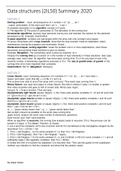Summary
Data Structures (2IL50) Summary 2020
- Course
- Institution
EN: Data Structures (2IL50) is a course given at Eindhoven University of Technology. It is a mandatory course for Bachelor Computer Science and Engineering students. It is given in the third quartile of the first year. Data structures delves deeper into the content discussed in Discrete Structures ...
[Show more]



